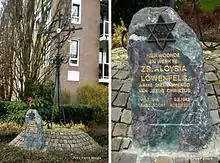Maria Aloysia Löwenfels | |
|---|---|
 Monument for Maria Aloysia Löwenfels at the location of the former convent | |
| Born | Luise Löwenfels 5 July 1915[1] |
| Died | 9 August 1942 (aged 27)[2] |
| Nationality | German |
| Occupation | Nun |
Maria Aloysia Löwenfels (5 July 1915 – 9 August 1942) was a German nun. She converted from Judaism to Catholicism. In 1936, she fled to the convent of the Poor Handmaids of Jesus Christ in Lutterade, Netherlands.[3] In 1938, she was confirmed as a novice.[4] On 9 August 1942, she was murdered in the gas chambers of concentration camp Auschwitz-Birkenau. In 2015, the Roman Catholic Diocese of Limburg announced that a beatification process had been started.
Biography
Löwenfels was born on 5 July 1915 in Trabelsdorf, Bavaria, Germany as Luise Löwenfels in a Jewish family. She went to high school at the Cloister Gnadenthal where she became attracted to Catholic faith.[4] On 25 November 1935,[4] Löwenfels was baptised in the convent of the Poor Handmaids of Jesus Christ in Mönchengladbach against the wishes of her family.[5] She started to work as a teacher.[4]
Löwenfels had been planning an escape to Great Britain.[2] In 1936, one of the children accused her of being Jewish, and threatened to expose her to the Gestapo.[4] Löwenfels fled the next morning to Geleen in the Netherlands.[2] In Lutterade near Geleen, there was a convent of the Poor Handmaids which was founded by German nuns who had fled Germany in 1875 during the Kulturkampf.[6] Löwenfels joined the convent, learned Dutch and started to work as a kindergarten teacher. On 17 September 1938, Löwenfels was confirmed by the Bishop of Roermond as a novice and named Maria Aloysia.[4]
Nazi Germany invaded the Netherlands on 10 May 1940.[7] Löwenfels was contacted by her brother that the family was trying to escape to the United States, however she decided to remain. In 1942, she was ordered to wear the Star of David.[2] In February 1942, there was an audience of the religious leaders of the Netherlands with Reichskommissar Seyss-Inquart during which the anti-Semitic policies were condemned.[8] On 20 July 1942, Johannes de Jong, Archbishop of Utrecht issued a pastoral letter to be read in all churches, protesting against the deportation of the Jews.[9] Seyss-Inquart retaliated by ordering the deportation of all Jews who had converted to Catholicism.[5]
On 2 August 1942, Löwenfels was arrested, and transported to Westerbork transit camp[4] where she arrived on 4 August.[10] On 7 August,[10] she was sent to concentration camp Auschwitz-Birkenau together with 987 other people. On 9 August, she was murdered in the gas chamber.[4][5][11]
Aftermath
The convent in Lutterade was torn down. In 2006, a monument was placed in remembrance of Löwenfels at the location of the convent.[3] Her brother managed to escape to the United States.[10][1]
In 2015, the Apostolic administrator of the Roman Catholic Diocese of Limburg in Germany announced that a beatification process had been started for Sister Maria Alyosa. The postulator is Christiane Humpert. The investigation has focused on whether Löwenfels died as a martyr.[5][2]
References
- 1 2 "The Central Database of Shoah Victims' Names". Yad Vashem (in English and Hebrew). Retrieved 17 May 2021.
- 1 2 3 4 5 "Seligsprechungsverfahren für Luise Löwenfels eröffnet" (in German). Archived from the original on 2016-02-03. Retrieved 17 May 2021.
- 1 2 "About Luise Löwenfels". Joods Monument. Retrieved 18 May 2021.
- 1 2 3 4 5 6 7 8 "Eine stille Frau: Luise, die zu Aloysia wurde". Kirchen Zeitung (in German). Retrieved 18 May 2021.
- 1 2 3 4 "Zaligverklaringsproces voor Joodse zuster geopend" (in Dutch). Archived from the original on 2016-11-18. Retrieved 18 May 2021.
- ↑ "Eerste steen (voormalig) klooster van de Zusters Arme Dienstmaagden van Jezus Christus (Geleen)". Charles Vos (in Dutch). Retrieved 18 May 2021.
- ↑ "De invasie 10 mei 1940". Tweede Wereldoorlog.nl (in Dutch). Retrieved 18 May 2021.
- ↑ Bas von Benda-Beckmann (2015). "De rooms-katholieke kerk en de grenzen van verzet in Nederland tijdens de Tweede Wereldoorlog". Niod Verkennend Onderzoek (in Dutch). NIOD Institute for War, Holocaust and Genocide Studies: 15.
- ↑ "20 juli 1942: vanaf de kansel van de kathedraal". Bisdom Haarlem-Amsterdam (in Dutch). Retrieved 18 May 2021.
- 1 2 3 "Löwenfels Luise". Spuren im Vest. Retrieved 18 May 2021.
- ↑ "Luise Löwenfels" (in Dutch). Network of War Collections. Retrieved 18 May 2021.